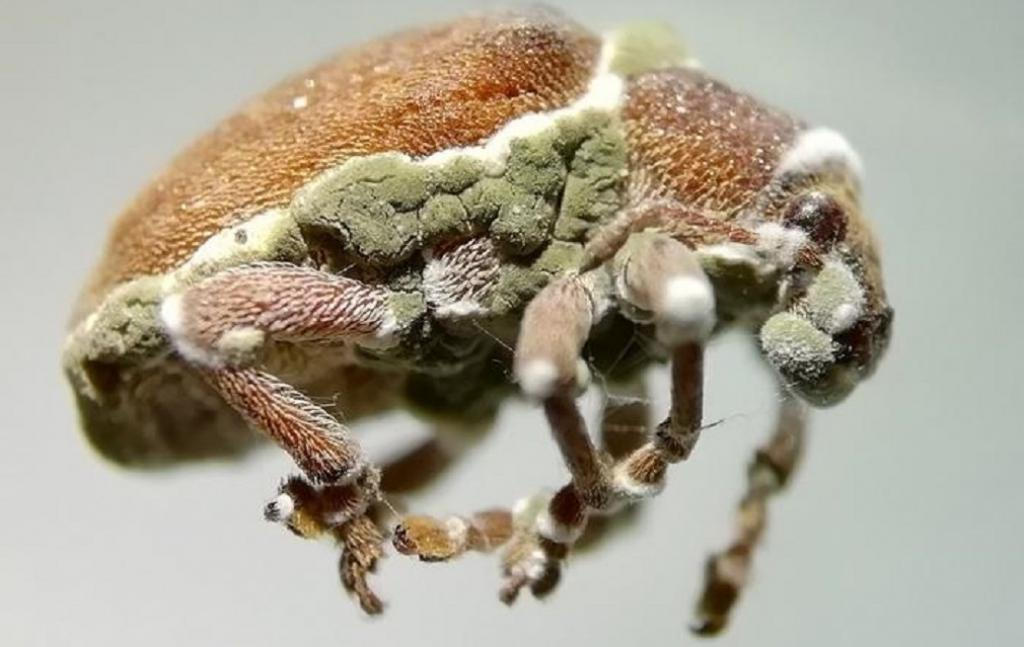Important Facts For Prelims
Natural Pathogenic Fungi to Save Eucalyptus Forests
- 13 Jan 2024
- 5 min read
Why in News?
Recently, scientists have found a natural remedy to protect eucalyptus forest plantations from a pest, eucalyptus snout beetle, which is known to cause serious damage to eucalypts.
- The researchers have managed to collect a naturally occurring pathogenic fungi and characterized it to turn it into a biopesticide for controlling beetle populations.
- Eucalyptus (evergreen tree) wood is a crucial material for paper pulp production.
What is Eucalyptus Snout Beetle?
- Eucalyptus snout beetle (Gonipterus platensis) is a leaf-feeding beetle that is a major defoliator of eucalypts, according to the Food and Agriculture Organization of the United Nations.
- The pest is indigenous to Australia but occurs in many countries throughout the world where eucalypts are grown.
- It can cause damage over vast areas as it has a great flight capability and gets transferred with transport of forest products.
- The beetle feeds on leaves, buds and shoots, resulting in stunted growth and deflation and causing heavy losses.
How can Fungi Control the Eucalyptus Snout Beetle?
- In the recent research, the scientists collected the fungi from naturally infected beetles in eucalyptus forest plantations and characterized them to develop a bio-pesticide for controlling the beetle.
- The fungi belong to the genera Beauveria and Metarhizium, which are known to infect and kill insects.
- Beauveria pseudobassiana and Metarhizium brunneum were the most virulent fungi.
- B bassiana was highly effective both by contact and ingestion, with a mortality rate of 100%.
- The fungi could be used to develop a bio-pesticide for sustainable forestry using integrated pest management.
- The fungi is developed by treating insecticidal activity, UV-B radiation tolerance among other parameters to ensure that recovered fungi are suitable to produce bio-insecticide and mass production and commercialisation.
UPSC Civil Services Examination, Previous Year Questions (PYQs)
Q. Consider the following organisms: (2013)
- Agaricus
- Nostoc
- Spirogyra
Which of the above is/are used as biofertilizer/biofertilizers?
(a) 1 and 2
(b) 2 only
(c) 2 and 3
(d) 3 only
Ans: (b)
- Biofertilizers are products containing carrier based (solid or liquid) living microorganisms which are agriculturally useful in terms of nitrogen fixation, phosphorus solubilisation or nutrient mobilization to increase the productivity of soil or crop.
- Classification of biofertilizers based on microorganism:
- Bacterial Biofertilizers: Rhizobium, Azospirilium, Azotobacter, Phosphobacteria, Nostoc, etc. Hence, 2 is correct.
- Fungal Biofertilizers: Mycorrhiza
- Algal Biofertilizers: Blue Green Algae (BGA) and Azolla.
- Actinomycetes Biofertilizer: Frankia.
- Agaricus is an edible fungus and is commonly known as mushroom. It is a saprophytic fungus found growing on soil humus, decaying litter on forest floors, in the fields, lawns, wood logs and manure piles. Hence, 1 is not correct.
- Spirogyra is a large genus of freshwater green algae found in shallow ponds, ditches and amongst vegetation at the edges of large lakes, generally growing free-floating. It is valued for human consumption, and is known as an important source of natural bio-active compounds for antibiotic, antiviral, antioxidant, anti-inflammatory, and cytotoxic purposes. Hence, 3 is not correct.
- Therefore, option (b) is the correct answer.
Q. Lichens, which are capable of initiating ecological succession even on a bare rock, are actually a symbiotic association of (2014)
(a) algae and bacteria
(b) algae and fungi
(c) bacteria and fungi
(d) fungi and mosses
Ans: (b)
- Lichen is not a single organism. Rather, it is a symbiosis between different organisms – a fungus and an alga or cyanobacterium. Cyanobacteria are sometimes referred to as ‘blue-green algae’, though they are quite distinct from the algae.
- Lichens are amongst the first organisms to colonize the barren surfaces (e.g., road cuttings, rock outcrops and volcanic ash) and prepare these areas for later plants by trapping moisture and windblown organic debris and then contributing to the organic deposits when they themselves die and decay.
Therefore, option (b) is the correct answer.






